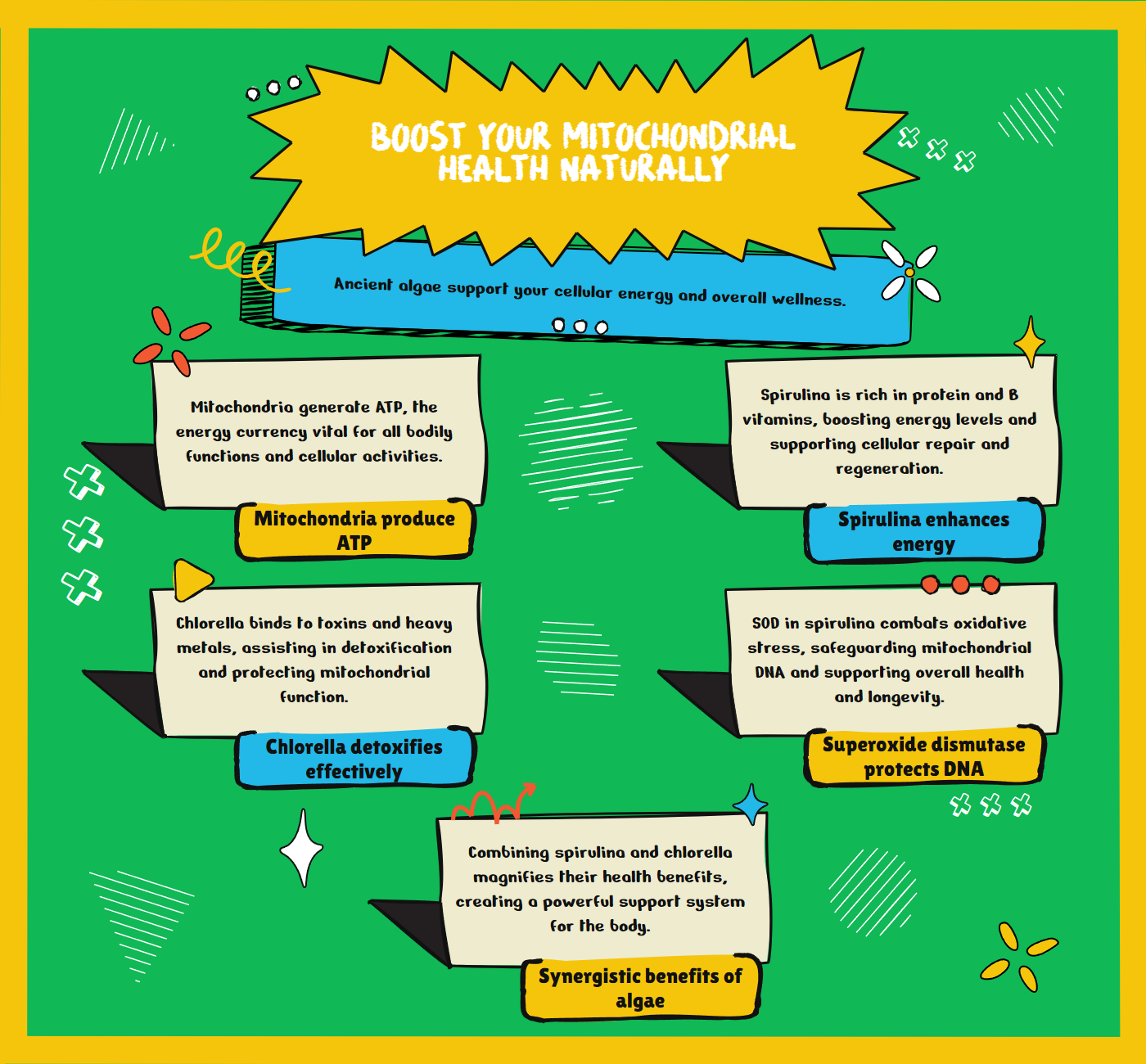
The Algae Revolution Your Mitochondria Have Been Waiting For
The Algae Revolution Your Mitochondria Have Been Waiting For
Your mitochondria are ancient bacteria living inside your cells. This symbiotic relationship, formed billions of years ago, created the foundation for human life as we know it. Today, these microscopic power plants determine your energy, longevity, and resistance to disease.
But they're under attack.
Modern life bombards mitochondria with toxins, stress, and oxidative damage. The result? Accelerated aging, chronic fatigue, and increased vulnerability to disease.
The solution might be as ancient as the problem.
The Mitochondrial Connection
Scientists now recognize that mitochondrial health stands at the center of human wellness. These tiny organelles produce ATP, the energy currency your body needs for every function. When mitochondria falter, everything suffers.
What's particularly fascinating is that the inner membrane of mitochondria evolved from cyanobacteria (like Spirulina) in a scientific process called endosymbiosis. This evolutionary connection explains why certain algae provide precisely what your mitochondria need to thrive.
Most antioxidants can't penetrate the double membrane that protects mitochondrial DNA. But specific compounds in microalgae can.
Spirulina and Chlorella: The Mitochondrial Superfood Duo
Two particular microalgae have emerged as powerful allies for mitochondrial health: Spirulina and Chlorella.
Spirulina, a blue-green algae that gained fame after NASA used it as a dietary supplement for astronauts, contains an impressive array of nutrients that support cellular energy production. With 60-70% protein content and 18 of 20 amino acids, it provides the building blocks your body needs for repair and regeneration.
What makes spirulina truly remarkable is its rich concentration of phycocyanin, which gives it its distinctive blue-green color. This compound has been shown to enhance mitochondrial function, increase ATP production, and protect against oxidative damage.
Chlorella, spirulina's green cousin, offers complementary benefits. While spirulina excels at energy production, chlorella specializes in detoxification and cellular protection.
The Superoxide Dismutase Factor
One of the most potent weapons against mitochondrial damage is an enzyme called superoxide dismutase (SOD). This remarkable antioxidant stops free radical damage to mitochondrial DNA, which is essential for health and longevity.
Spirulina contains the highest concentration of SOD found in any food source. This makes it uniquely effective at protecting mitochondria from the oxidative stress that accelerates aging and disease.
Unlike synthetic supplements, the SOD in spirulina exists within a complete nutritional matrix that enhances its bioavailability and effectiveness.
Chlorella: The Detoxification Powerhouse
While spirulina excels at energy production, chlorella specializes in removing the toxins that compromise mitochondrial function.
Chlorella's tough cell wall binds to heavy metals, pesticides, and other environmental toxins, escorting them safely out of the body. This detoxification support is crucial for mitochondrial health, as these organelles are particularly vulnerable to toxic damage.
Beyond detoxification, chlorella contains violaxanthin, an antioxidant that significantly reduces inflammation. This matters because inflammation is recognized as the leading cause of death worldwide, contributing to everything from heart disease to neurodegenerative conditions.
Chlorella also contains the highest concentration of chlorophyll found in any food, up to 500 times more than leafy greens. This plant pigment supports blood building, tissue repair, and further detoxification.
The Synergistic Effect
While each algae offers impressive benefits individually, their power multiplies when used together.
Spirulina provides immediate energy support through enhanced ATP production, while chlorella removes the toxins that would otherwise impair mitochondrial function. Together, they create a comprehensive approach to cellular health.
This synergy extends to their nutrient profiles as well. Spirulina excels in protein content and B vitamins, while chlorella offers superior levels of chlorophyll and healthy fats like omega-3s.
The complementary nature of these superfoods makes them ideal partners in any mitochondrial support protocol.
Practical Implementation
Integrating these powerful algae into daily life requires understanding their optimal use.
Many health experts recommend taking spirulina in the morning to support energy production throughout the day. Its protein content and B vitamins make it an excellent addition to a morning routine.
With its detoxification properties, Chlorella often works best when taken in the evening. This timing supports the body's natural detoxification processes during sleep.
For those new to algae supplements, starting with a modest dose—around 10 tablets or 1-2 grams of each daily—allows the body to adjust gradually. For more therapeutic effects, this can be increased over time to 30 tablets or 3-6 grams daily.
Unlike synthetic supplements that can become toxic at higher doses, spirulina and chlorella are whole foods. This means they can be safely consumed in larger amounts as needed.
Beyond Mitochondria: Whole-Body Benefits
While the mitochondrial benefits justify using these superfoods alone, their advantages extend throughout the body.
Research has shown that regular consumption of spirulina and chlorella can support:
Immune function: Both algae enhance natural killer cell activity and modulate immune response.
Cardiovascular health: They help reduce inflammation, lower LDL cholesterol, and support healthy blood pressure.
Brain function: These algae's antioxidants and essential fatty acids support cognitive health and may help reduce neuroinflammation.
Digestive wellness: Chlorella, in particular, supports beneficial gut bacteria and aids in digestive healing.
Athletic performance: Enhanced oxygen utilization and faster recovery make these algae popular among athletes.
The Future of Cellular Health
As research into mitochondrial function continues to evolve, the importance of these ancient algae only grows more apparent.
Their unique ability to support cellular energy production while protecting against damage places them at the forefront of anti-aging and health optimization strategies.
Spirulina and chlorella are particularly valuable because they are whole foods rather than isolated compounds. This means they provide a complex array of nutrients that work synergistically, as nature intended.
For those seeking to support mitochondrial health, enhance energy production, and protect against the cellular damage that drives aging, these microscopic algae offer a solution that's both powerful and elegant in its simplicity.
The revolution in cellular health isn't coming from a pharmaceutical laboratory. It's arriving from ancient waters, where these remarkable organisms have perfected their nutrient profiles for billions of years.
Your mitochondria have been waiting for them. Perhaps you have too.
